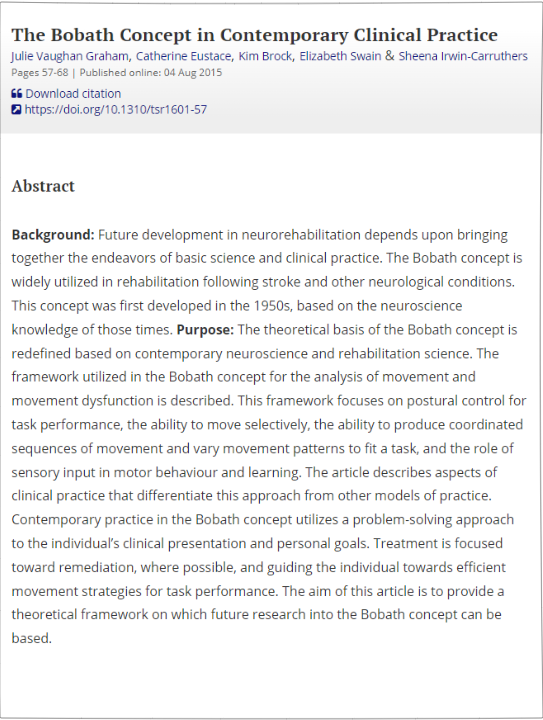Revising our Understanding of the Evidence and the Practice of Bobath/NDT with Julie Vaughan-Graham
- wiredondevelopment

- Nov 20, 2023
- 4 min read
Updated: Jul 4, 2024

Julie Vaughan-Graham PT, PhD
Advanced IBITA Instructor (Honorary Life Member 2020)
Founder, Physio-Logic and iNeuroRehab
Assistant Clinical Professor (Adjunct), School of Rehabilitation Science, McMaster University, Hamilton, Ontario, Canada
Adjunct Lecturer, Department of Physical Therapy, University of Toronto, Canada
This WiredOn interview is a passionate and engaging conversation with Dr Julie Vaughan-Graham, PT, PhD. Julie shares insights from her research on the Bobath concept, and the importance of postural control, selective movement and movement variability and efficiency. We discuss clinical reasoning, the challenges of research, and the future of physio/ physical therapy. If you've ever had questions about the state of the evidence in this area of practice, you're going to find this conversation enlightening.
For handy links to things we've discussed in this interview, scroll down to the Resources Section at the bottom of the page.
Julie Vaughan-Graham Short Bio
Julie graduated from St. Thomas’ Hospital, London, England in 1986 and has worked in the area of neurorehabilitation since 1988. Julie emigrated to Toronto in 1991, initially taking a position at Lyndhurst, Spinal Cord Injury Centre, and then later opening her own private community neurorehabilitation practice, Physio-Logic, in Toronto in 1993.
Julie completed her MSc in Neurological Rehabilitation at Leeds Metropolitan University, UK in 2010, and her PhD at the Rehabilitation Sciences Institute, University of Toronto in 2016. Julie has had a number of post-doctoral positions and she holds an Assistant Clinical Professor (Adjunct) position in the School of Rehabilitation Science at McMaster University and, an Adjunct Lecturer appointment in the Department of Physical Therapy at the University of Toronto.
Julie recently founded iNeuroRehab, an e-learning platform for clinicians. She is an Advanced IBITA instructor, and instructs post-graduate clinical neurorehabilitation courses across Canada and internationally.
Listen, enjoy, share...
Podcast Highlights
03:52 minutes - Finding your passion again when you're starting to burn out
09:40 minutes - An outdated model of clinical practice?
15:05 minutes - The state of the evidence and what's in a name?
22:38 minutes - The Evolution of the Bobath Concept
25:16 minutes - Facilitation and Sensory-Motor learning
30:42 minutes - The Bobath Clinical Framework and contemporary research
35:37 minutes - Quality of Movement
40:55 minutes - Motor Behavior vs Motor Control
46:08 minutes - Clinical Reasoning in Rehabilitation
52:35 minutes - Efficiency in movement
56:53 minutes - Assessment and Treatment
59:26 minutes - "Fixing" vs accommodating for disability
1:04:53 minutes - Clinical skill development
Resources
clickable links to take you right to the information you're looking for
Julie Vaughan- Graham
Mentioned
Mary Lynch Ellington - https://www.researchgate.net/profile/Mary-Lynch-Ellerington
Dr. Charles Tatter- https://www.youtube.com/watch?v=Vlc-llC5hCI
Cheryl Cott- https://www.rehab.utoronto.ca/faculty/cheryl-cott/
Casimirs Project - DMD - https://www.parentprojectmd.org/watch-casimirs-duchenne-video-assessment-dva-arise-study-webinar-recording/
Essential Books
Bobath Concept: Theory and Clinical Practice in Neurological Rehabilitation 1st Edition
by Sue Raine (Editor), Linzi Meadows (Editor), Mary Lynch-Ellerington (Editor)
Authored by members of the British Bobath Tutors Association, Bobath Concept: Theory and Clinical Practice in Neurological Rehabilitationis a practical illustrated guide that offers a detailed exploration of the theoretical underpinning and clinical interventions of the Bobath Concept. The evolution of the Bobath concept is brilliantly captured in this volume. The recognition that the best inhibition may come from engaging the patient in normal activities is an example of the way one of the notions central to the original Bobath Concept has developed. In short, the Bobath Concept lies at the heart of an approach to neurorehabilitation that is ready to take advantage of the rapidly advancing understanding, coming from neuroscience, of brain function in, in particular, of the effects of and responses to damage, and the factors that may drive recovery. It is no coincidence that neuroplasticity figures so prominently in the pages that follow.’
Emeritus Professor Raymond Tallis BM BCh BA FRCP FMedSci LittD DLitt FRSA
This book guides the reader through general principles to more specific application of neurophysiological principles and movement re-education in the recovery of important areas, including moving between sitting and standing, locomotion and recovery of upper limb function.
Bobath Concept: Theory and Clinical Practice in Neurological Rehabilitationwill be invaluable to undergraduate and qualified physiotherapists /occupational therapists and all professionals working in neurological rehabilitation.
Covers the theoretical underpinning of the Bobath Concept.
Presents a holistic, 24-hour approach to functional recovery.
Focuses on efficient movement and motor learning, to maximise function.
Forges links between theory and clinical practice.
Illustrated throughout.
The Bobath Concept in Adult Neurology 2nd Edition
by Bente Elisabeth Bassoe Gjelsvik (Author), Line Syre (Author)
New edition of the acclaimed guide to the Bobath Concept for the management of neurological dysfunction
The pioneering text by internationally renowned Bobath instructor and therapist Bente Gjelsvik is now in a revised and expanded second edition. The Bobath Concept in Adult Neurology, Second Edition, is updated with the latest theoretical insights, research literature, and clinical guidelines to provide an evidence-based, practice-oriented guide to the assessment and treatment of patients with lesions of the central nervous system. Bridging the gap between theoretical assumptions and everyday therapy practice, the book offers an understanding of the interaction between the central nervous system, the musculoskeletal system, movement, and function, and helps readers apply their knowledge to form hypotheses through clinical reasoning in the rehabilitation of adults with neurological conditions.
Highlights:
Completely revised case histories chapter with entirely new patient cases
Key coverage of recent clinical trials and research studies
Restructured and reorganized chapters for a more logical presentation of content
Concise descriptions of the central nervous system and the neuro-musculo-skeletal systems, motor control, and neural and muscular plasticity
Useful discussion of the International Classification of Functioning, Disability, and Health as a basis for assessment
More than 200 lucid photographs and illustrations aid in quick grasp of the material
The new edition of this seminal volume contains the theoretical information, clinical details, and practical examples of the Bobath Concept for the management of neurological disability. It is a must-read for physical therapists and occupational therapists at all levels who seek the best assessment and treatment outcomes for neurologically impaired individuals.
des
Please note: these book links go through to Amazon Affiliate Program
Thanks for your support!
Video






























Comments